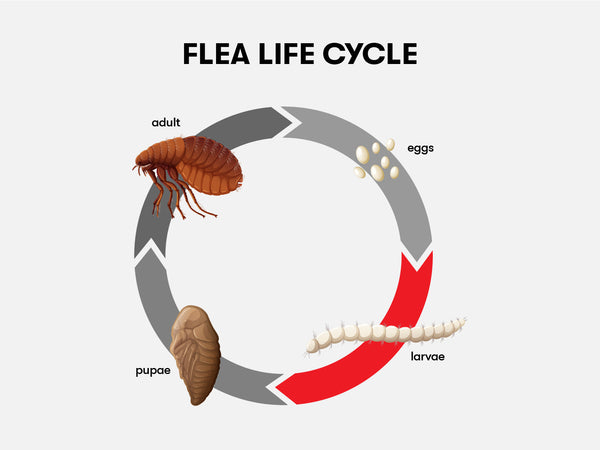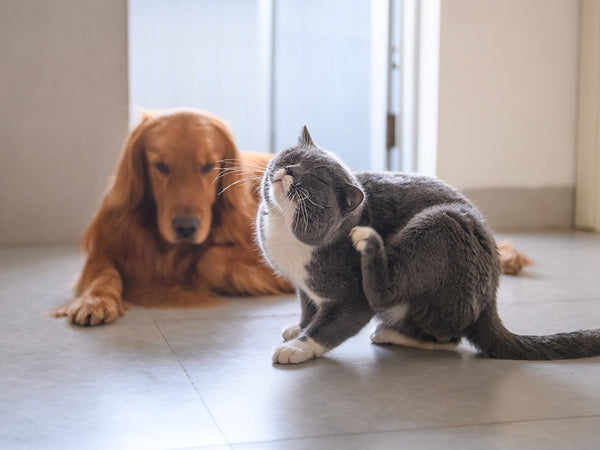How to Choose the Best Harness & Leash for Your Dog
Written by: Richard Rowlands, Pet Health Expert
Choosing the right harness and leash for your dog can be challenging.
If you’ve ever stood in an aisle of harnesses and leashes, utterly confused, or scrolled endlessly through options in an online store, not knowing which to select or where to start, you’re not alone!
There are so many options available and while variety is the spice of life, it can also be overwhelming for those of us unsure about what our dog needs.
Like many products for your dog, the buying decision should be based on their specific needs as well as yours. This varies by dog size, breed, and what activities you’ll be doing with your four-legged friend.
Find the Perfect Harness & Leash
In this post, we’ll give you an overview of harnesses and leashes so you can get to know the various types that exist and the differences between them. Then, we’ll discuss what to consider when choosing the perfect harness and leash so the next time you head out to shop or go online to buy one, you’ve got the info and confidence needed to make a solid decision.
How to Choose a Harness for Your Dog
Before we get into different types of harnesses, let’s chat about what harnesses aren’t.
Harnesses are not collars.
Collars are a piece of material that is placed around a dog’s neck. Traditionally, they were used for restraint, but these days are more about fashion and occasionally protection.
Collars are also ideal for holding identification tags and medical information for your dog in case they ever get lost. Every dog should have a collar for that reason!
But when it comes to walks, runs, or hikes a quality harness of the appropriate make will be a much better choice.
Harnesses are more elaborate than collars. They’re pieces of equipment composed of various materials, including straps, and sometimes webbing, that fit comfortably around the torso of your dog and securely buckle or fasten together.
In the past, many pet parents opted for collars when walking their dogs, but these days the various harnesses available offer so many advantages over collars that they are the way to go.
The right harness will outperform a collar because it is:- More comfortable
- More secure
- Better for your dog’s neck
- Good for training
It’s important to be familiar with the different kinds of harnesses that are on the market so that you can choose the right option for your dog.
Back Clip Harness
This kind is widely available and probably the most popular. They’re basic, versatile, and usually come in affordable options. They get their name from the metal D-loop on the back of the harness where the dog leash attaches. They’re great because your dog can’t reach the leash to chew on it and you and your dog are less likely to get tangled or tripped up by them. But beware! Some breeds like huskies were born to pull and this kind of harness may not be a good match for them if they’re not well trained yet.
Ruffwear Web Master Harnesses are a great example of this style.
Front Clip Harness
These are very similar to the back clip variety, but the loop to attach your dog’s leash will be on the front, where your dog’s chest is. This type of harness is also known as an “anti-pull” or “no-pull” harness because it’s great for teaching your pups and older fur friends alike good leash manners. That’s why many dog trainers love them. Just be sure to hold the leash high enough so no one gets tangled.
Arcadia Trail Lightweight Harness are a great example of a sturdy, with a front clip harness function.
Dual Clip Harness
The best of both worlds! This harness is versatile, having loops on the back and front, giving you the ability to swap between the two. These are ideal for backpacking when you might be alternating between on and off leash adventures, and if you're run/walking through the city when you want to switch between faster running and easy walking.
Day Packs & Backpack Harnesses
This type of harness comes in all sizes and is ideal for when you want your dog to help out with some of the heavy lifting. They’re made with sturdy, heavy duty pockets or saddles, so your dog can carry items when you’re off camping or hiking. They provide storage for everything from food and water to toys. Just keep in mind that the weight should be proportional to what your dog can handle. They may be best to avoid if your dog is a breed prone to back problems like dachshunds or corgis.
The Arcadia Trail Packable Backpack is a fine example of this sort of harness and is also lightweight, waterproof, and easy to store when not in use.
Safety Harness
This is a specialized type of harness for when you’re taking your dog on the road with you. Having a way to secure your dog and keep them safe in your vehicle is a must, so think about a safety harness as the dog equivalent of a safety belt. This harness will attach to the safety belt, keeping your most precious of cargo safe in the event of an accident or even a sudden stop.
6 Important Factors for Dog Harness Selection
Now let’s cover some really important factors to consider when buying your harness, regardless of what style you choose to go for.
1) Size
Your dog’s harness should be snug, but not tight. Like advice commonly given for collars, you should be able to fit a couple of fingers between the harness and your dog. Anymore and it’s too loose! They should never be able to back out of it. If it’s a front clip harness, the loop or ring should sit high on their chest. Don’t be afraid to return the wrong size harness for a better fitting one.
2) Material
Many durable, high-quality harnesses that you’ll find will be made of synthetic materials such as polypropylene, nylon, or polyester. They’re generally soft against your dog’s body but durable and washable should the need arise.
3) Visibility
Some harnesses will feature reflective strips and materials that will help your dog be seen. This is important at night, of course, but also for dogs who go for walks in rainy, foggy, or even snowy weather.
As an example, Ruffwear’s Front Range Harness incorporates material that provides the low-light visibility we’re talking about here.
4) Design
Not all harnesses are designed the same. We already went over the different types, so we won’t emphasize those here. However, those different choices will come in over-the-head or step-in options. The latter is great for little dogs, but keep in mind that the majority are back clip. As well, you’ll have a host of different colors and looks to choose from that can convey your dog’s personal style or brand.
5) Construction
Have a good look at how the harness is made and if you’re unsure, check online to see what the manufacturer says about their own product. You want to be sure that the stitching on the harness is done properly (the more stitches the better) and reinforced at points that may take pressure from pulling, especially with larger breeds.
6) Hardware
The hardware on the harness will generally be made from either plastic or metal. Plastics should be tough and durable. You’ll usually find that buckles and strap tighteners are made from plastic. Metal is also common, being used for loops, adornments, strap tighteners, and sometimes parts of the buckles or fasteners. Nickel-plated steel or brass are both suitable.
How to Choose a Leash
Some might think that leashes would be simpler and more straight forward than harnesses. Well, yes and no.
While traditional leashes still exist, there are a variety of things to consider when choosing one. And as time goes by, new innovations have come in this area as well. So much like harnesses, your dog’s breed, how well trained they are, and the activities that you’re engaging in together, will dictate which option is best.
You may also want to consider having a few options depending on what you’re doing and where you’re going.
Flat Leashes
This is the industry standard and probably what you have in mind when you think about a dog leash. They’re generally made of nylon or rope and depending on the model, could be thick or thin. They’ll attach to your dog’s harness with a simple metal clasp. They’re great because they come in a variety of styles and lengths, including long leashes which are up to 15 feet. Many are also washable.
We’re really in love with the designs of the West Paw Outings Dog Leash. Talk about stylish flat leashes!
Slip Leashes
This style won’t work with your harness, but some people use them for training or when they need to quickly throw a leash on their dog. The leash itself actually works as a collar as well. As the name implies, the material of this leash is pulled through a metal or plastic ring to form a loop that will fit over your dog’s head. When you pup pulls, the collar area tightens. They’re not ideal for long term use and you should definitely be sure they’re sitting right on your pup to avoid any choking issues.
A great emergency leash of this variety is Ruffwear’s Just-A-Cinch 5 Foot Leash. They recommend keeping it in your car for those situations when you really need a leash, which is a great idea.
Hands Free Leashes
This may sound crazy, but trust us, they do exist! Hands free leashes are usually a combination of two parts. One, a waist pack of some kind that will sit around your waist, with a special detachable leash that buckles at either end. One side will fasten to your waist pack, the other to your dog’s harness. These are fantastic for folks who go hiking, running, or who combine the two for trail running.
The Arcadia Trail Hands Free Leash and Waist Pack is a perfect choice in this category and even comes with a shock absorbing leash.
Off-Leash Leashes
Wait… what? Another confusing one, we know! These leashes are short and can be attached to your dog’s collar or harness when you let them off leash. The idea is that they are short enough to not drag on the ground but provide something you can quickly grab onto should the need arise. They’re mostly for medium and large breeds, as our little dog friends just don’t have the ground clearance to pull these off.
If you’re interested in one of these, we recommend the Arcadia Trail Easy Grab Leash.
Retractable Leashes
These generally have plastic handles where a mechanism stores and loops a long cord that will attach at the opposite end to your dog’s harness. Most have a locking mechanism that will allow you to control length and the freedom your dog has. They’ve slowly fallen out of fashion with the advent and better availability of longer flat leashes. They also tend to offer little control over your dog, poor grip, and are known to break when dogs pull too hard (even little ones).
6 Important Factors for Leash Selection
1) Length
The standard dog leash is 6 feet in length, but these days options abound! There are super short leashes that keep your dog close by your side, great for training or busy areas. You can also find long leashes (up to 10 feet) and longline leashes (up to 30 feet) which offer more freedom and are great for sport training.
2) Material
Most leashes that you’ll see in the standard length are going to be made of nylon. However, other common materials will be metal (chain), cotton rope, and leather. Choose the material based on the activities you’ll be doing with your dog and the climate you live in. Leather may not stand up so well to inclement weather, for example, but it will definitely look good walking down the street on a warm spring, summer, or fall day.
3) Visibility
Just like with harnesses, many leashes will feature reflective strips or be made of materials that will help your dog and the leash itself be seen when it’s dark or visibility is not at its best. The latter is especially important, so no one gets tripped by accident!
4) Design
Not all leashes are designed the same. You may want one to match your dog’s harness. But also, some have different bells and whistles like additional clips for carrying poop bags and treats. One thing to pay attention to here as well is your end of the leash as some handles are bigger/smaller and may not be comfortable or easy to grip and hold for all folks, especially for those of us who might have arthritis or other issues to think about.
5) Construction
The same rules apply here as they did for harnesses. Look at how the leash is made, paying attention to any stitching and where it attaches to the hardware. If you’re looking at a metal (chain) leash, be sure those loops are seamless!
6) Hardware
The main hardware on leashes is going to be where they attach to your dog’s harness (the clasp). This absolutely must be made of metal. There will be different types including bolt snaps, bolt snaps (with swivel or fixed heads), trigger clasp snap hooks, lobster clasp hooks, and more. You want to make sure that they are strong, and any spring mechanisms are well constructed. If in doubt, don’t go for it.
Conclusion
All these options may seem overwhelming. Don’t let them be! You have the knowledge now to make a solid decision. And remember, that decision might be having more than one harness or leash for your dog or graduating to different options as your dog ages and their needs change.




















